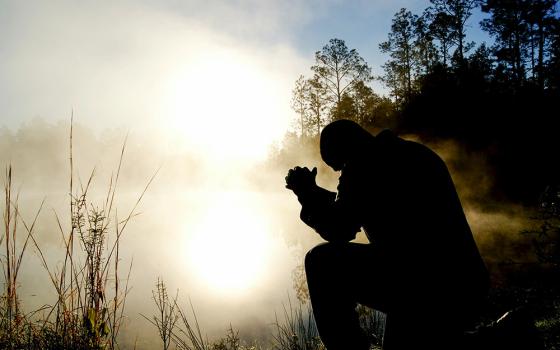
NCR will publish a five-part essay by Immaculate Heart of Mary Sr. Sandra Schneiders, Professor of New Testament Studies and Christian Spirituality at the Jesuit School of Theology at Berkeley, on this site beginning Jan. 4 and running through Jan. 8.
The essay, titled “Religious Life as Prophetic Life Form” explores the meaning of religious life today and comes during a controversial three-year Vatican study of U.S. women religious congregations.
NCR Editor Tom Fox interviewed Schneiders, asking her about the purpose and timing of her five-part essay.
NCR: Why did you write this article, why now?
Schneiders: To begin with “why now,” because the Vatican investigation of U.S. women religious has created what the Chinese ideogram for “crisis” means, namely, a situation of danger and opportunity. Religious and their life are in danger from three directions.
- First, they do not know what the Vatican plans to do with whatever information it collects and, if those who suspect that the conclusions were reached before the investigation began are correct this danger is not illusory.
- Second, there is the danger that some religious will become so disgusted, discouraged, disheartened, even justifiably angered by this implied questioning of the integrity of their lives and the authenticity of their ministries, and by the clear signals that they are expected, if they want ecclesiastical approval, to get back “in the box” that defined their pre-conciliar lives, that they will simply give up, either on religious life itself or on their own vocations to it, or on a church which seems to be defined by a narrow, rigid, exclusively institutional ecclesiology.
- Third, there is the danger that generous younger women who are intelligent, courageous, motivated not by medieval romanticism or elitism but by love of the world for which Christ died, and who feel called to the following of Jesus in ministerial religious life will decide that they do not want to spend their lives and energy struggling with a patriarchal institution which denies their full human and Christian personhood.
I wrote this article in hopes of helping to counteract these dangers by helping religious seize the opportunity this situation offers to reflect deeply on the real meaning of religious life as a participation in the prophetic vocation and mission of Jesus and on our ministry as participation in his work of announcing Good News to the poor even unto the laying down of his life for those he loved. Part of seizing this opportunity is the deepening experience of solidarity among religious themselves within their congregations and across congregational lines, which fosters courage in the face of misunderstanding and persecution. I want to promote this sharing of experience and self-understanding.
NCR: What do you hope to achieve by the essay?
Schneiders: I want to do two things, to the extent that is possible in a short essay. First, I want to analyze the current situation of religious life under investigation as a “two level” event analogous to the “two level” opposition to Jesus that led to his rejection by the religious establishment of his day. Second, and on the basis of the understanding of our life as a reflection of Jesus' own mission and ministry, I want to encourage the clear articulation and courageous claiming of our experience, which will encourage us to live the vocation to which we have been called, willingly living (not being passively overwhelmed by) whatever suffering that may involve.
The authorities of Jesus' time thought they were protecting the religious establishment of Judaism by getting rid of a politically dangerous “messiah” figure who was upsetting the fragile religious status quo within which their power was guaranteed by Rome. But they “knew not what they were doing”, because their deeper opposition, of which they were undoubtedly unconscious, was to Jesus' reinterpretation of the very meaning of God's revelation, God's work in the world. Jesus, God's prophet whom the Spirit of God had anointed to proclaim “good news to the poor,” was announcing a “new world.” He was undoing the “old world” of salvation reserved for the pure and earned by scrupulous observance of law by the religious elites, and opening up the “new world” of God's absolutely inclusive love and unconditional mercy to the unclean, the sinners and the outcasts. In that sense, he was announcing the end of their world to the religious authorities who had to get rid of him before what he announced became reality.
Religious are under investigation, at one level, for upsetting the ecclesiastical status quo of the Church understood as a divine right absolute monarchy. They are resisting patriarchal control of their own lives which is a threat to hierarchical absolutism in general. They are perceived, correctly, as promoting the ecclesiology of Vatican II. But the real and deeper issue is that religious are participating in the prophetic ministry of Jesus, announcing the Good News of salvation by their preferential ministry to the outcasts of society and church. By declining to serve as enforcers of dogmatic and moral absolutism they are proclaiming salvation that comes not through blind submission of mind and will to laws and office-holders or helpless dependence on religious mechanisms that are put out of their reach, but through humble acceptance of the power and desire of an all-loving God to save even those who are “hopeless” in their own eyes or the eyes of authority.
I also want to encourage religious (myself first of all) to look within, individually and in community, to reclaim and articulate the prophetic vocation to which we responded at profession, perhaps without realizing even vaguely where that could and would lead because of the times in which we were born. In reclaiming that vocation we must recognize and accept that tension with institutional authority -- defined by the latter as “disobedience” -- is part of our commitment to true obedience to God not men. Obedience is practiced in prayerful attention to all the “voices of reality” of our times, to the “signs of the times” in which we live. This attention, at every moment, leads to careful discernment that facilitates the three-way encounter among God, God's people, and the concrete historical situations in which God's reign must be incarnated in this world.
NCR: How is this essay connected to the one you wrote last October in NCR on “Ministerial Religious Life?”
Schneiders: The connection is in the close following of Jesus that constitutes religious life. In the first article I was trying to show how what I called the “lifestyle” of ministerial religious was that of Jesus and his original band of itinerant disciples. Because ministry is intrinsic to the life of these religious, as it was to the life of Jesus and first disciples, their lifestyle (dress, dwelling, prayer life, activities, etc.) is determined by their itinerancy, their availability to and their solidarity with (rather than separation and distinction from) those whom they serve, their understanding of common life in terms of economic interdependence rather than sociological structure, and so on. Religious live the “mixed life” of deep contemplation grounding urgent public action, as did Jesus, and their lifestyle reflects that reality.
In this essay I am going beyond the “lifestyle” to the “prophetic nature of the life” itself. I am suggesting that the very heart of ministerial religious life is its participation in the prophetic mission of Jesus. That mission, of proclaiming the Good News of salvation to the poor, is enacted in their interpretation of the Gospel into concrete historical situations of suffering. And this will inevitably lead to tension between the status quo of Church as hierarchical power structure enforcing doctrinal uniformity and moral subordination, and the Church as the Body of Christ in this world caring by preference for those on the margins, those who do not and cannot measure up, those who can only say, “Lord, have mercy on me, a sinner” even when they cannot promise to meet the standards.
| The essay in five parts:
Part One: Religious Life as Prophetic Life Form, Jan. 4 Part Two: Call, Response and Task of Prophetic Action, Jan. 5 Part Three: What Jesus taught us about his prophetic ministry, Jan. 6 Part Four: Tasks of those who choose the prophetic life style, Jan. 7 Part Five: Religious life: sharing Jesus' passion, resurrection, Jan. 8 Read NCR's coverage of the apostolic visitation of U.S. women religious here: Index of stories Read an interview with Sr. Schneiders. She explains why she wrote this essay: Schneiders to explore meaning of religious life today |



